
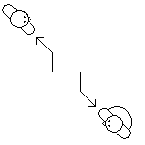
(Man is facing up the hall, Woman down.)
(Man and Woman are side by side again, Man on the left, facing up the hall.)
(They are facing each other, a little to each others' left, on a diagonal to their original orientation.)
Fia Guielmina (second or B version), by Domenico. One couple. Difficulty = Level 4
| Steps: | Sempio (in 4 and 6), Doppio (in 4 and 6), Saltarello (in 4), Saltarello Tedesco, Piva (in 6), Ripresa Portugalesa (in 4), Mezavolta, Voltatonda, Movimento, Reverenza, Ripresa (in 6) |  |
| Start: | Couple side by side, facing up the hall, holding hands, Man on the left. | |
 | ||
| [Two-bar introduction on accompanying tape] | ||
| 1-2 | Saltarello Tedesco Left, Saltarello Tedesco Right, and drop hands, Woman ending with a Mezavolta Right. (Man is facing up the hall, Woman down.) | |
| 3 | Sempio Left, Sempio Right. | |
| 4 | Ripresa Portugalesa Left, moving forward. (Both dancers are on a diagonal, such that they can look at each other.) | |
| 5 | Woman Doppio Right, turning to face up the hall, | |
| as | Man Doppio Right, ending in Mezavolta Right. Take hands. (Man and Woman are side by side again, Man on the left, facing up the hall.) | |
| 1-4 (2nd time) | Repeat. | |
| 5 (2nd time) | Doppio Right to meet. Take right hands. (They are facing each other, a little to each others' left, on a diagonal to their original orientation.) | |
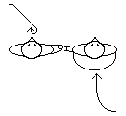 Bar 5 (1st time) |
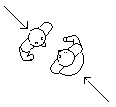 Bar 5 (2nd time) |
 Bar 6 |
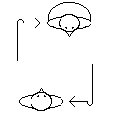 Bars 8-11 (Not including the last Mezavolta) |
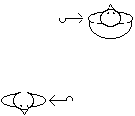 and Bar 12 | ||
| 6 | Sempio Left, Sempio Right, changing places, rotating about a quarter circle. (Man is now facing down the hall, Woman up, approximately side by side, and to each others' right.) | |
| 7 | Reverenza Left. Drop hands. | |
| 8-10 | Sempio Left, Sempio Right, Doppio Left, Doppio Right, ending with a Mezavolta Right. The steps should be a little smaller than usual. (They are now facing, and about 14 steps apart. | |
| 11 | Ripresa Left, facing each other, ending with a Mezavolta Left. (They are now facing away again, Man down the hall and Woman up.) | |
| 12 | Ripresa Right, back to back. | 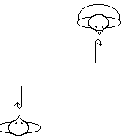 |
| 13-14 | Doppio Left, Doppio Right ending with a Mezavolta Right. The steps should be a little smaller than usual. (Dancers are now facing each other, a little to each others' right, about 24 steps apart.) | |
| 15 | Reverenza Left. | |
| 16 | Woman Doppio Left with a Movimento on the last beat, ending with feet together and her weight on both. | 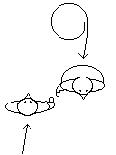 Bars 25-26 |
| 17 | Man Doppio Left ending with a Movimento on the last beat. | |
| 18 | Woman Doppio Left ending with a Movimento on the last beat. | |
| 19 | Man Sempio Left with a Movimento on the last beat, then Woman the same. (They are now about 13 steps apart.) | |
| 20 | Man Voltatonda (Saltarello Left, clockwise.) | |
 | ||
| 21-24 | Woman Voltatonda (4 Pive starting Left, clockwise). | |
| 25-26 | Piva Left, Piva Right, together. (They are now about 1 step apart, slightly to each others' right, Man facing up the hall and Woman down.) | |
| 27-30 | 4 Pive, starting Left, taking right hands and circling clockwise around each other, Woman ending with a Mezavolta Right. (End side by side, facing up the hall, Man on left, as at the beginning.) | |
Teaching Notes
In order to make sure that the steps taken apart, in Section III, are kept moderately small, while the ones returning, in Section IV and V, are larger, it may help to say the dancers should act like they don't want to separate, and really want to get back together.
The reconstruction for Section V given above is quite simple, but may not match the music very well. If the dancers are finding it difficult to follow the music, the alternate Section V, given in the notes below, may be easier for them.
Recordings
Bel Danzare has two versions:
Danzare has two versions:
Forse - Introduction of two twiddly phrases with pauses after. Section I ends differently the second time, and runs into Section II, which is also different than our reconstruction. The easiest solution is to dance Section I as usual, the second time, and then drop the reverenza of Bar 7. Section V is slow and a bit short; the last piva can be turned into a sempio. Repeats.
Mesura - Two-bar drum introduction. Section V is a bit short; the last piva can be turned into a sempio. Repeats.
The song that follows, "A Florence la joyose cite/Helas la fille guillemin", can also be used for the dance. There is no introduction. Section I is short one beat, so the ripresa of Bar 4 should be done with only three beats of music instead of four. On the second playing, it is short another beat, so the last doppio should be done with only three beats. Section V is quite slow.
Music Leonardo - One long held note for an introduction. Section I is only 19 beats, so the last doppio should just have three steps, without a pause on the fourth beat. Section II is three instead of two bars, so the reverenza in Bar 7 can be done for two bars. Section IV is also missing one beat, so the man can finish his voltatonda of Bar 20 as the woman starts hers. Repeats Section I (twice), only, at end.
Musica XV ("A Florence/Helas la fille/en ma chambre") - No introduction. Section I is only 19 beats; dropping the last beat of the ripresa in Bar 4 works best. Section II is different and a bit shorter; doing the sempii and reverenza of Bars 6 and 7 faster works, as Section III is also quite fast. Section V is only nine pive, but there is a pause afterwards, so the tenth piva of our reconstruction will fit in the pause. The dance is played three times, the first and third being sung.
Ren ("La Fille Guillemin") - No introduction. Section I is short two beats, so do both the ripresa and last doppio, of Bars 4 and 5, with only three steps and without a pause on the last beat. Section II is still in 4/4 and is short one beat. Section III is quite fast. Section V is quite slow, and only has nine bars, but the last piva can be done afterwards, as there is no repeat.
Sonare - Two and a half bars of introduction (i.e. ten beats). Quite easy to follow. Section V is nine bars long, so the last, circling, figure of Bars 27-30 is done with three, instead of four, pive. Repeats, ending with a long note..
Dance Notes
This is the second of the two dances called Fia Guielmina, the first one being danced to the same music but needing two couples. This one can also be danced by two couples, but the second couple starts beside the first couple and then does exactly what they do.
 |
Section I: In this reconstruction the dance is treated as being mostly bi-directional; the dancers separate, come together, and face up the hall so they can repeat the same steps in the same orientation. Another solution is that in Bar 5 they do not turn to align themselves exactly with the hall, remaining at about a 45-degree angle to their original direction. After doing Section I again they would be about 90 degrees out of alignment with the hall. This would mean that they would be in their original positions, Man on
 |
would then have them rotate a full half turn.
This may seem a rather minor difference, but it raises the question of how rigorous the fifteenth-century choreographers were about staying on a strict perpendicular grid. Very likely they were not, and it is perfectly possible that the entire dance was done on different axes. Although we mostly kept the dance bi-directional, we did use angles when they were much easier, as at the end of Bar 5 (2nd time). (See below.)
Bars 1-2: PnD describes the movements of each of these bars as being three sempii and two continenze, while RVat has a doppio and two fast continenze, and Sc and MOe have a doppio and three continenze. Since this is close to what we are using for a saltarello tedesco we decided to use that step. However, as the term "saltarello tedesco" is not used in the sources, it is quite possible that the required movements were considered distinct enough that they needed to be described.
Bar 3: No mezavolta is specified for the woman in PnD, which only says that she 'torna indriedo' (returns to the rear) with the same steps as the man. It is possible that she backs away from him, which means her ripresa portugalesa would also move to the left side of the hall, resulting in a much less dynamic version.
Bar 5 (2nd time): We decided to have the dancers end still at an angle to their original orientation, instead of returning to their original positions (but with the man facing down the hall). The other placement is possible, but makes it awkward to take right hands for the next section. This is a similar problem as is faced in the dance Prexonera. (See Prexonera, Bar 12, and also Leading in the Introduction.)
In PnD the man ends this section with a voltatonda (presumably replacing the mezavolta). We decided that this was a pivot turn on the last beat, which is dramatic and makes the section look like it is being repeated, identically, until the last moment. As it is potentially dangerous (Vivian's knees can attest to this) and does not change the man's positioning at all, we decided to leave it out. A dancer who is willing to take the risks can add it back in. However, if the dancers were meant to return to their original position, rather than ending at an angle, this voltatonda might be a 3/4 spin, to enable the man to end facing the right side of the hall, so his right hand, at least, is closer to the woman's.
Section III: All the mezevolte are presumed to take no time, as PnD explicitly states that there are eight tempi of bassadanza, and there are eight tempi worth of steps without the mezevolte.
Section IV: In Bar 17 no foot is given for the man's doppio in PnD and Rvat, but the other two sources say it is on the left. The next step that the man takes is also on the left in all but Rvat. It is tempting to put the man's doppio on the right, instead, so that he alternates feet, but because he ends his doppio with a movimento (which in our reconstruction ends with weight on equal feet), and then waits while the woman moves, the usual alteration is not necessary. The same decision was reached regarding the second doppio that the woman performs, in Bar 18.
Bar 19: The sempii with movimenti used here are from Sc and MOe, and were chosen as matching the previous doppii. Rvat merely has sempii, while PnD describes them as "passo sempio comenzando col pe sinistro retirandose apresso el drito".
Bar 20: The voltatonda is described in PnD as three sempii with a salteto. The sempii are presumed to be one beat each, the same as in Bars 1-2, making the entire sequence equivalent to a saltarello. The direction of turn is not given, but because the woman is slightly to his right, a clockwise turn seems more appropriate so that he is turning toward, rather than away from, her.
Section V: The easier version of this section, found in Sc and MOe, is followed, and has even been simplified, as there is a "saltarello in tempo" (probably a one-beat hop) called for at the end of Bar 24 and Bar 26. The version from PnD, which matches the pattern of the music better, is included below for those that prefer the more challenging version.
Bars 21-24: As in Bar 20, the direction of turn for the voltatonda is not given.
Bar 30: The woman's mezavolta is not specified, but we presumed that she should end facing up the hall, as she started. As our reconstruction does not repeat, this is not actually too important.